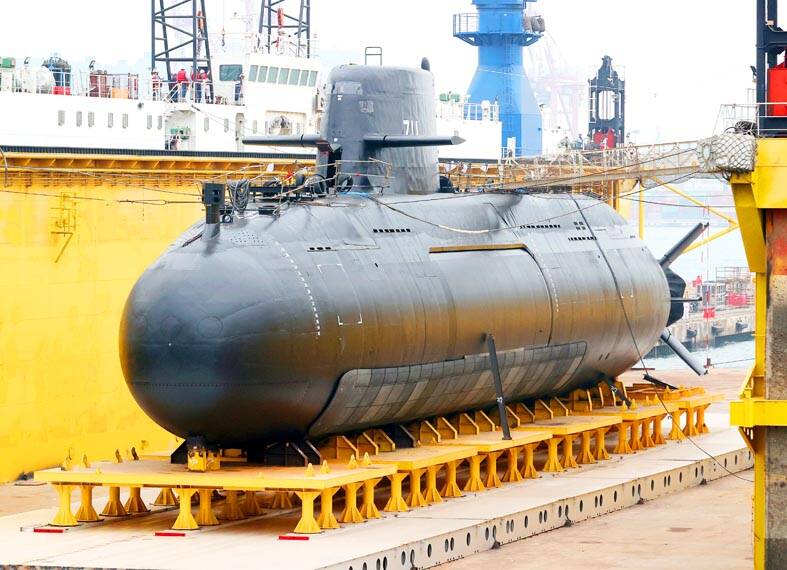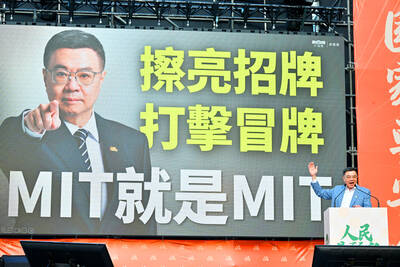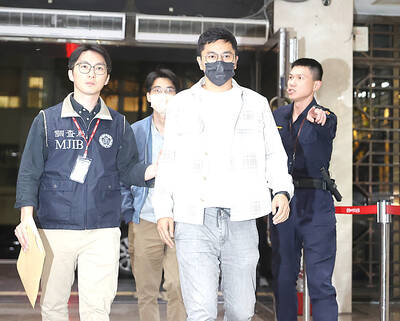The government has allocated a record NT$647 billion (US$20.24 billion) for defense spending in fiscal 2025, accounting for about 2.45 percent of GDP, the Executive Yuan said yesterday after it approved the general budget plan.
The defense budget includes NT$479 billion to be appropriated by the Ministry of National Defense to cover operational expenses, as well as a special budget of NT$90.4 billion to procure new fighter jets and fund purchases of weapons to enhance the nation’s sea-air combat capabilities.
It also includes a non-profit special government fund of about NT$80.6 billion.

Photo: Lee Hui-chou, Taipei Times
The defense spending for next year marks an increase of 7.7 percent from this fiscal year, which is higher than the government’s forecast of a rise in GDP of 3.26 percent this year.
Defense spending this year accounted for 2.5 percent of GDP.
“We are aware of many discussions about the proper percentage of defense spending compared with GDP. Some say 3 percent, others say 5 percent and others say that a dramatic increase in defense spending would reduce the budget for other government policies,” Ministry of National Defense comptroller Lieutenant General Hsieh Chi-hsien (謝其賢) told reporters at a news conference after the weekly Cabinet meeting. “We respect the various views regarding this issue.”
“However, we must still compile the defense budget based on weapons needed to shore up our defenses,” Hsieh said. “We also need to take into account the nation’s financial situation.”
“We will not engage in an arms race with other countries,” he added.
The defense budget has grown steadily in the past few years, Hsieh said, adding that reaching 3 percent of GDP depends on whether the government can acquire key weapons it has requested.
The rise in funding for military operations and maintenance, as well as payments for weapons, jointly contributed to an unprecedented increase in defense spending, Hsieh said.
Cabinet spokesman Chen Shi-kai (陳世凱) said in a statement that Premier Cho Jung-tai (卓榮泰) has officially approved a submarine development project, which aims to build seven advanced vessels from next year to 2038.
The project is estimated to top NT$284 billion, Chen said.
“The government will continue to enhance the nation’s defense capabilities and enforce the policy of building our own military aircraft and ships to show our determination to maintain peace and stability in the Indo-Pacific region, build a resilient nation and defend our sovereignty,” he said.
Based on the general budget plan approved by the Executive Yuan, the aggregate revenue that can be appropriated is NT$3.1534 trillion, an increase of NT$428.2 billion from this year. Aggregate expenditure next year is expected to top NT$3.1325 trillion, an increase of NT$280.6 billion from this year. The remaining funds would be NT$20.9 billion.
Aside from defense spending, 26.5 percent of the general budget would be used to cover social welfare expenditures; 19.3 percent would pay for education, scientific development and culture; 17.3 percent would be used for economic development; 8.8 percent would cover general administrative expenses, while 5.8 percent would be used to shore up retirement funds.
The remaining 7.5 percent would be used to pay debt and interest, provide subsidies, develop communities and protect the environment.
Directorate-General of Budget, Accounting and Statistics Minister Chen Shu-tzu (陳淑姿) said that the government would borrow NT$231.3 billion, accounting for 6.9 percent of total annual expenditure, below the legal cap of 15 percent.
Cumulative debt by the end of next year is expected to top NT$6.81 trillion, accounting for 28.6 percent of the average nominal GDP in the previous three years, she said, adding that it is down 1.1 percentage points from this year and 12 percentage points below the cap of 40.6 percent stipulated in the Public Debt Act (公共債務法).

Seventy percent of middle and elementary schools now conduct English classes entirely in English, the Ministry of Education said, as it encourages schools nationwide to adopt this practice Minister of Education (MOE) Cheng Ying-yao (鄭英耀) is scheduled to present a report on the government’s bilingual education policy to the Legislative Yuan’s Education and Culture Committee today. The report would outline strategies aimed at expanding access to education, reducing regional disparities and improving talent cultivation. Implementation of bilingual education policies has varied across local governments, occasionally drawing public criticism. For example, some schools have required teachers of non-English subjects to pass English proficiency

‘FORM OF PROTEST’: The German Institute Taipei said it was ‘shocked’ to see Nazi symbolism used in connection with political aims as it condemned the incident Sung Chien-liang (宋建樑), who led efforts to recall Democratic Progressive Party (DPP) Legislator Lee Kun-cheng (李坤城), was released on bail of NT$80,000 yesterday amid an outcry over a Nazi armband he wore to questioning the night before. Sung arrived at the New Taipei City District Prosecutors’ Office for questioning in a recall petition forgery case on Tuesday night wearing a red armband bearing a swastika, carrying a copy of Adolf Hitler’s Mein Kampf and giving a Nazi salute. Sung left the building at 1:15am without the armband and apparently covering the book with a coat. This is a serious international scandal and Chinese

TRADE: The premier pledged safeguards on ‘Made in Taiwan’ labeling, anti-dumping measures and stricter export controls to strengthen its position in trade talks Products labeled “made in Taiwan” must be genuinely made in Taiwan, Premier Cho Jung-tai (卓榮泰) said yesterday, vowing to enforce strict safeguards against “origin laundering” and initiate anti-dumping investigations to prevent China dumping its products in Taiwan. Cho made the remarks in a discussion session with representatives from industries in Kaohsiung. In response to the US government’s recent announcement of “reciprocal” tariffs on its trading partners, President William Lai (賴清德) and Cho last week began a series of consultations with industry leaders nationwide to gather feedback and address concerns. Taiwanese and US officials held a videoconference on Friday evening to discuss the

PERSONAL DATA: The implicated KMT members allegedly compiled their petitions by copying names from party lists without the consent of the people concerned Judicial authorities searched six locations yesterday and questioned six people, including one elderly Chinese Nationalist Party (KMT) member and five KMT Youth League associates, about alleged signature forgery and fraud relating to their recall efforts against two Democratic Progressive Party (DPP) legislators. After launching a probe into alleged signature forgery and related fraud in the KMT’s recall effort, prosecutors received a number of complaints, including about one petition that had 1,748 signatures of voters whose family members said they had already passed away, and also voters who said they did not approve the use of their name, Taipei Deputy Chief Prosecutor